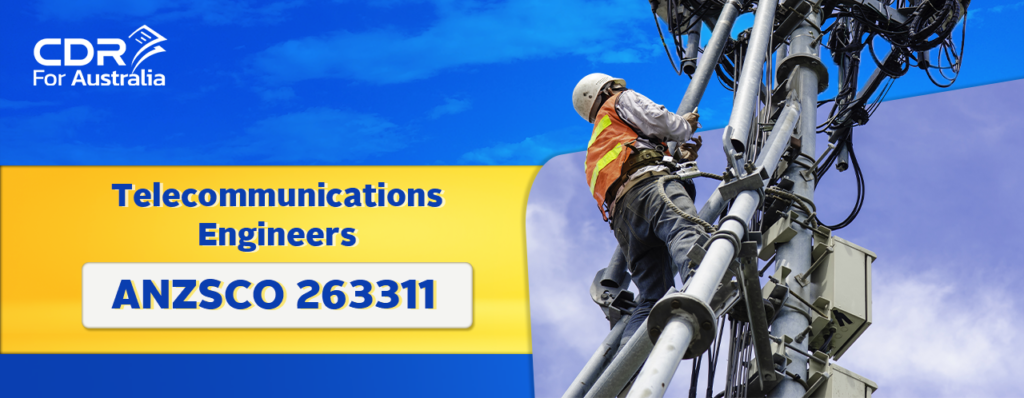ANZSCO 263311 Telecommunications Engineers
Designs and develops telecommunications systems, devices, and products.
Skill Level: Level 1 or Equivalent
Skill Assessment Authority: Engineers Australia (EA) / Australian Institute of Management (AIM)

Specializations of Telecommunications Engineer
- Signals Officer (Army) (NZ)
- Computer Systems Integrator
On the Occupation List of Telecommunications Engineer:
- 489 (S/T) Occupations List
- 482 TSS Visa Medium Term List
- 407 Training visa occupations List
- 482 TSS Visa Regional Occupation List
- 189 Skilled Independent and Family Sponsored 489
- Occupations List and 485 Graduate Work Stream
- 190 State/Territory Sponsored
- 186 ENS Visa Occupations List
- 187 RSMS Visa Occupations List
- 491 – Skilled Work Regional (provisional) visa (subclass 491) Occupation List
- 494 – Skilled Employer-Sponsored Regional (provisional) (subclass 494) – Employer-sponsored stream
Not on the Occupation List of Telecommunications Engineer:
- 482 TSS Visa Short-Term List
Visa Provision for Telecommunications Engineer
Any visa under the General Skilled Migration (GSM) Program may be sought since the profession is identified on the MLTSSL as a high-demand occupation in Australia. Skilled Independent Subclass 189, Skilled Work Regional Subclass 491, and Skilled Nominated Subclass 190 are among the tickets available in this category. Additionally, you might be eligible to apply for a number of employer-sponsored visas provided you have a firm employment offer.
⋙ Unit Group 2633
To guarantee that telecommunications equipment functions as expected, telecommunications engineering professionals choose the best telecommunications hardware and software combinations. Telecommunication engineering specialists research and analyze interruption, intelligibility, and clarification to reduce and avoid current and future problems. There can be a need for licensure or registration.
Skill Level Required
The majority of jobs in this unit category require a skill set equivalent to a bachelor’s degree or better. The formal qualification may be replaced by at least five years of relevant experience or applicable vendor certification. In some cases, in addition to formal education, appropriate experience and/or on-the-job training may be necessary (ANZSCO Skill Level 1).
Exceptions for Unit Group 2633
- Australian Graduate exceptions apply in some states/territories
- Priority Skilled Lists may apply a specific requirement in some states
- Countries free from submitting IELTS or OET include the UK, Canada, New Zealand, the US, and Ireland. Where mandatory licensing or registration is required, you must demonstrate a level of English sufficient to meet licensing/registration or a minimum IELTS, or equivalent, whichever is higher.
Occupations in this Group
- 263311: Telecommunications Engineer
- 263312: Telecommunications Network Engineer
Language Proficiency to be Eligible
- IELTS result with a minimum score of 6 (L, R, W), 7 in speaking and 7 overall;
- OET result with a minimum grade of B in all sections;
- TOEFL iBT with a minimum score (L:12 R:13 W:21 S:23 overall L93);
- PTE Academic with a min score of 50 (L, R, W), 65 in speaking, and 65 overall.
Telecommunications Engineer ' Responsibilities '
- Engineers in the field of telecommunications search for and select new telecom sites.
- Telecommunications engineers create the paperwork for permission and submit it.
- The process includes the creation of building blueprints by telecommunication engineers and the ensuing approval.
- Rules, regulations, policies, and processes are used by telecommunications engineers to guarantee uniformity in the provision of telecommunication networks.
- To ensure that telecommunication networks are interconnected, telecommunications engineers design, implement, and configure satellite and digital data systems.
- The interface of telecommunications systems with hardware from diverse suppliers, service providers, and users is ensured by telecommunication engineers.
- To set priorities, telecommunications engineers develop engineering project proposals.
- To calculate the cost of equipment, materials, and services, telecommunication engineers describe the scope, meaning, and requirements.
- Telecommunications engineers consider whether to purchase new goods and services from producers.
- Drawings used in telecommunication systems are created and analyzed by telecommunication engineers.
- Standard drawings and guidelines for the use of telecommunications equipment are created by telecommunication engineers.
- To ensure the essential efficiency of communications, telecommunication experts decide on suitable hardware and software standards.
- Modern telecommunications network demands and challenges are identified by and analyzed by telecom engineers.
- Telecommunication engineers research and analyze interruption, intelligibility, and clarification to reduce and avoid current and future problems.
Why Choose CDRforAustralia?
Every Career Episode, Summary Statement and CPD is prepared in compliance with the guidelines set out by Engineers Australia and carefully and comprehensively vetted to ensure originality and technical accuracy. We point out your experience in handling telecom infrastructure projects, troubleshooting communication networks, and applying engineering principles to real-world systems.
CDRs prepared by our professional experts have helped hundreds of Telecommunications Engineers migrate to Australia. Your telecommunication skills have international acclaim. One will get a personalized and EA-approved CDR that reflects engineering mastery and career success.

